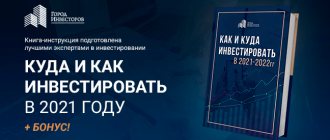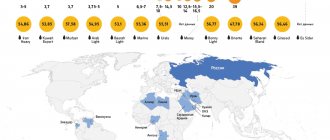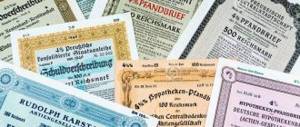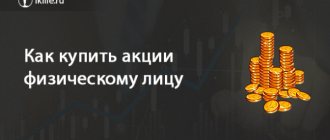Good day. Trading in the stock market is not an easy task and requires high-quality preparation. Without proper knowledge, it is extremely difficult to get a positive result. Unfortunately, economic universities do not teach this science. But there is a lot of useful information on the Internet. In this article you will receive step-by-step instructions on how to play on the stock exchange and where to start learning to trade on the stock exchange from scratch if this is your first time deciding to tackle this topic.
Game on the stock exchange for beginners: how to start trading and what exchanges there are
The financial exchange at one time became the most discussed topic on remote earnings via the Internet. Millions of novice traders tried to make a million-dollar fortune in this lesson, and only 10% of them succeeded.
Profitable trading on the stock exchange is possible for beginners using minimal capital. However, in order to achieve success from the first attempts in this matter, you need to know the basic rules and subtleties of technical analysis. If carried out correctly, then more than 80% of bets will only be a plus.
First, let's understand the basic terms:
- A broker is an intermediary who enters into contracts with a particular organization and buys their shares. Subsequently, he tries to sell these shares to clients as much as possible or places them at the disposal of traders.
- A trader is a professional who plays on the stock exchange. The same speculator makes money on the price difference.
- Stock exchange is a place for selling and buying securities (stocks, bonds, futures, options, etc.).
The basis of any analysis is the principle of “bulls and bears”; they represent the price movement up or down. The main participants in exchange exchange are divided into two types:
- Bulls buy stocks cheap and sell them when prices rise. For example, once one Apple share cost $2, but now it costs $160. And the profit from the sale is 8,000%.
- Bears - make money when stocks fall. First, they borrow shares from the market for $10 per share and sell them to someone else at the current price. As soon as the price drops, they buy the security again, but for $5. As a result, they repay the debt and remain profitable.
In addition, the market is rich in other animals:
- Hare - players on small fluctuations within one session (up to 10 minutes).
- Wolf are professional traders, their forecasts constantly come true.
- Pig is a player who holds a position until the very end. Even if the trend has completely changed and is declining.
- The moose is the opposite of the wolf, it constantly loses.
- Lemming is a novice trader, he acts according to the instructions of professionals and completely trusts him.
- Shark is a major investor and market player. His investments directly influence the fluctuations of the chart and it is the sharks who control the market.
In essence, Forex is a huge exchange exchange where some people buy and others sell securities, resources or things. They fight among themselves, and the price movement for a particular resource depends on their investments.
Therefore, there are always winners and losers, and this balance remains approximately equal. And the entire market operates on this principle, while some buy securities, others sell them. The larger the speculators' investments, the stronger the fluctuations in the charts.
What you will find in this book
The book offers a new approach to introducing the basic concepts of the stock market. It is written in accessible language, with minimal jargon, and explains market terms in a clear manner.
It is especially valuable that the proposed materials and exercises help to consolidate what has been learned. Each section provides a detailed explanation of the basic concepts and real-life examples to work through. Additional exercises and test questions allow the reader to better understand what is presented. At the end of each section, its content is presented graphically in the form of a diagram that facilitates quick repetition of the material. The section concludes with a list of additional recommended sources of information.
The book deals mainly with the stock markets of the UK and the USA with their exchanges, procedures for issuing securities, trading securities, etc. This approach ensures consistency between the parts of the book. In addition, it is these markets, due to their size and position, that often set the rules of the game for others. To study the specifics of other markets around the world, we recommend that you contact directly the exchanges operating on them, contact information for which is given at the end of the book. Also take advantage of additional sources of information
for each of the sections.
How to trade on the stock exchange online - 5 tips for a beginner on how to play on the stock exchange on the Internet
As you know, trading on the stock exchange is not an easy task for beginners. Despite the advertisements, speculation in securities is a rather complex and risky activity and directly depends on the ability to correctly analyze charts.
Statistics show that more than 95% of beginners lose their initial deposit within 1-2 months. The main reasons are haste, excessive self-confidence and acting on the emotional level (uncontrollable risks).
In order not to lose all your finances on the first go, we recommend that you follow the following rules.
No. 1. Calm and sanity
Despite the simplicity of the actions, traders get very nervous and freak out. After all, they are risking real money and do not want to lose it. When angry, the brain stops carefully analyzing the situation and acts at the level of emotions and instincts. And this is a sure way to lose.
To calm yourself down in time, find an additional activity: draw a picture, read a book, solve equations, or make a plan for future actions. Keep your mind busy with another task to relieve stress.
No. 2. Rule of 3 trades
In practice, novice speculators do not know how to stop in time and act until they completely lose their entire deposit. With each subsequent loss, stress increases, so use a simple rule.
If you lose more than 3-5 bets in a row in one session, then leave the game for a day. During this time, conduct a thorough analysis and think about why mistakes were made.
These precautions help relieve emotional overload and teach self-control. Over time, you can reduce the time of distraction to 5 hours.
No. 3. Analyze the situation and train
Constant learning and self-improvement is the only path to success. Spend at least 1 hour a day analyzing the market, your own and others’ mistakes. Improve yourself regularly, read analytical materials and learn new strategies.
Make it a habit to remember previous mistakes (write them down and save graphs). Over time, similar situations will come across and you won’t have to make the same mistake twice.
No. 4. Follow the money management system strictly
Almost all advertising agents promote aggressive play with maximum risk under the pretext “those who do not take risks do not live their lives to the fullest.” To avoid losing your investments in the first session, follow 5 rules:
- Set the permissible maximum consumption per day, for example, no more than 5%.
- For bets, use an amount that you don’t mind spending. Professionals take a transaction volume of no more than 1-2% of the total deposit. This way you can maintain balance for a long time.
- Apply precautions in the form of stop-loss and take-profit. They automatically close positions so that the trader does not oversleep the right moment. Place these points so that the ratio of wins to losses is at least 1.5 to 1 or more.
- For the first time, select 2-3 resources and work only with them. There is no need to first scatter yourself over a bunch of options; it is better to carefully study the patterns of one market and trade based on it.
No. 5. Be prepared for losses and risks
A professional speculator is an emotionally reserved person. He knows how to admit defeat and has exceptional self-control of actions and emotions. Prepare yourself mentally for losing and don’t dwell on losses. It is impossible to get 300% profit without risky trades.
Beginners do not want to admit defeat and hold a losing position for as long as possible. This is the wrong approach; if you haven’t guessed the trend for the planned period of time, give up your position. Do not rely on chance and emotions, only cold-blooded analysis and statistics.
Possibility of replenishing a brokerage account
A very important parameter. For example, you wanted to top up your brokerage account, but the broker’s office is not in your city. Transferring money to an account using the details is such a task. Moreover, commissions must be paid to banks providing such services. And bank commissions simply stifle citizens.
In my opinion, the coolest way is to go to the office with money. I don’t take into account that we are going there on a tram with a bag of money. But it’s more reliable that they will arrive accurately and there will be no commissions.
I don't think you'll do this often. After all, everyone came to the exchange just to accelerate the initial deposit and grow it to cosmic figures. Well, maximum once a year you will report money to the brokerage account.
But I also like the service of transferring money through a mobile application from some brokers. But there will be a commission to another bank too. There is no escape from this.
I don’t see any point in opening cards from banks of the same broker that are part of the same financial group. The fewer different cards, the better.
This is approximately what I found from our brokers.
BKS
- From a card of any bank in the “My Broker” application
- By bank transfer using the details from any bank account
- Through BCS cash desks
- Free transfer from the "Broker" card in your personal account "BCS Online"
Opening
- Transfer from a bank account
- Transfer of funds from another professional participant in the securities market
- Top up your account remotely using online banking
- Top up your account remotely with any other money transfer, if you can specify bank details during the transfer
Keith Finance
- You can deposit funds by bank transfer through any bank.
Finam
- Cashless transfer from a bank account
- Through the cash desk of Bank FINAM
- Using a bank card (0% commission) from a FINAM Bank debit card
- Using a bank card when topping up from a bank card of any third-party bank (1%)
Here, as they say, everyone has their own option. I very rarely deposit money into a brokerage account, so I prefer the option of depositing money through the broker’s cash desk in the office. This is such a strange preference I have!
How to make real money on the stock exchange - TOP 4 proven methods
It is impossible to open all orders absolutely without loss, and it is not necessary to become a speculator yourself in order to make a profit from transactions. Let's look at 4 ways to make money without being a professional trader.
Method No. 1. Trust financial management
An experienced speculator, before acting only for profit, first studies for at least 1 year and burns out on his own mistakes. In order not to repeat a similar path, you can open a PAMM account (all trading is conducted by a professional, but with funds entrusted to him).
According to statistics, PAMM brings from 5 to 15% of income per month, sometimes more. But remember that there is a high risk of fraud and investments in PAMM are not insured. In essence, the contract is carried out “on word of honor,” so be careful before choosing a partner and read reviews from different sources.
Method No. 2. Independent trading
If you don’t want to trust anyone, then try to become a successful speculator yourself. It’s not difficult to get your first profit, the chance of luck is 50%. However, for stable operation, you need to learn to predict with at least 70% confidence, for this you need:
- choose the optimal strategy;
- learn to use analytical tools;
- know the patterns of market reversals;
- control risks;
- acquire permanent capital;
- regularly learn and improve;
- be able to quickly analyze a situation on a chart.
To achieve these results, it takes professionals on average from 1 to 2 years of constant work and training.
Do not believe advertising with promises to increase investments by 2 or more times in just a month. Such income is only possible for high risks and an aggressive strategy. Even pros increase their deposit by up to 30% in a month with normal risk.
Aggressive play for large sums is promoted by the online broker itself. He knows that the crowd wants to get rich in the shortest possible time and therefore buys fake “successful traders”; they themselves are professionals in their field and already clearly understand how the market behaves. They promote aggressive play and actually win. They say some secrets, but in fact they hide the most important and subtle points.
Method number 3. Teach beginners how to trade on the stock exchange
If you already have your own trading experience or were able to create a unique strategy, then you can sell your own knowledge to beginners. But for the business to take off, strong evidence is needed for buyers, such as payments, online trading with students, etc.
Nowadays there are many scammers in this area, so not everyone can make money on unique knowledge. But if you try, you can get rich in the Forex information business.
Method number 4. Earning money from affiliate programs
Any business needs new clients and therefore employers are willing to pay partners who bring new users to the system. In order for advertising activities to bring maximum profit, it is advisable to own a well-promoted financial blog, website or other visited resource.
For each client they pay from 40 to 60% of the broker's profit from referral transactions. The greatest profit from the leaked deposit.
Therefore, many bloggers on YouTube simply do not want their viewers to win and offer them the most risky strategies. Even if you are lucky a couple of times, it is easy to lose your finances again. And as arguments they show a luxurious life: expensive restaurants, hotels on the seashore, a luxury car, etc. Each lost bet is a percentage for the affiliate’s treasury.
conclusions
There is no clear answer to the question of which broker is better. It all depends on the needs of the trader himself . Above we have discussed companies that meet the requirements of most traders and investors. Among them there are options for active Forex trading, and there are also brokers for passive investing.
If you do not agree with this list of TOP brokers, suggest your options in the comments. If you have any questions about the trading conditions of the listed companies or just need advice, do not hesitate - write, together we will find a solution .
This concludes the review of the best brokers, all the best and see you soon. Don’t forget to subscribe to blog updates so you don’t miss the latest articles on current topics.
If you find an error in the text, please select a piece of text and press Ctrl+Enter. Thanks for helping my blog get better!
Brokers for stock trading: how to choose the best one
All manipulations with securities are carried out through an intermediary, so the indicators of the minimum rate, ease of working with the terminal, stability of payments, etc. directly depend on his choice.
- Spread is the difference between the purchase and sale prices at one point in time (essentially the speculator’s earnings).
- Lot is a conventional unit of measurement of currency. 1 lot = $100,000, the broker buys it and subsequently provides it to traders.
- Leverage is the ratio of borrowed capital to equity. Having placed a bet of 500 rubles with a leverage of 1:1000, the speculator is actually trading 500,000 rubles, but into a borrowed account.
If you trust a young company, then look at the following indicators:
- Financial indicators of spread, leverage, lot size. These are the basic terms on which the effectiveness of a trading strategy depends.
- Availability of bonuses and promotions. Any business must pay off, so a broker will not just give out money to everyone. Most likely, in order to work out the bonus, you need to fulfill additional conditions, etc.
- Ignore abstract reviews. Remember that, first of all, this is a risky profession and beginners who lose a large amount of money blame everyone around them except themselves. Therefore, all kinds of reviews are left based on emotions. You can check the organization using their licenses from the bank and analytics from professional world-class magazines (they are difficult to bribe).
- Don’t be fooled by a bunch of pictures and recommendations from video bloggers. Consider their opinion of the partner and his conditions, but double-check all words personally.
- Compare the provided charts periodically when trading with other resources. Sometimes companies change statistics for users and deliberately change the price of certain resources so that transactions go into the minus on the user’s account.
There are many stock agents and each of them offers favorable conditions for employees. Now let’s look at 4 of the most famous and time-tested companies that fully meet all the requirements described above.
No. 1. Alpari
In 1998, Alpari opened in Russia. Within a short time, the company gained momentum and in 2004 registered its ten thousandth anniversary user. In 2005, a charity and sponsorship fund was opened, thanks to their support, more than 100 children were saved and many sporting events were sponsored. In 2021, the FX Empire portal recognized Alpari as the best online broker in the “reliability” and “innovation” categories.
Advantages over competitors:
- more than 70 analytical tools;
- leverage 1:1000;
- no commission;
- minimum deposit – $1;
- bonus program, competitions and promotions;
- reliable and time-tested company.
The minimum entry amount depends on the account type; beginners can start with at least $1, but it is recommended to use at least $100. Plus, when you make your first deposit, you get up to a 100% bonus.
No. 2. Broker Zerich (JSC IC "ZERICH Capital Management")
The company began operating in 1995 and from the very beginning bought out many securities from various enterprises (Rostelecom, Lukoil, Tver Escalator Plant, etc.). In 2008, Zerich is experiencing a crisis, but maintains its leading position. In the period from 2014 to the present time, various innovations have been introduced and auxiliary projects have been opened.
Positive sides:
- time-tested;
- many supported trading platforms;
- PAMM;
- entry into world markets.
The commission for the work is 1 rub. for every transaction. The minimum deposit to open an account is 30 thousand rubles. (approximately $500). The commission for withdrawing earned funds is from 0.1% to 0.12% with a minimum fee of 500 rubles or $12.
No. 3. Broker Finam (JSC Investment)
First, in 1994, Finam carried out its activities to create an information and analytical bulletin “investor's portfolio”. The business continued in this direction until 1998, at which time the company received a license from the Federal Commission for the Securities Market of the Russian Federation. In 2001, the name was changed from “Finam-analyst” to “Finam” and subsequently the company gradually developed and entered the TOP 5 best brokers in Russia.
Advantages:
- no commission;
- leverage 1:200;
- minimum deposit 5$;
In general, over the entire period of operation, the company has accumulated a lot of positive reviews. First of all, they note the stability of payments and the quality of technical support.
No. 4. Broker Otkritie (Otkritie Broker JSC)
In 1995, OJSC VEO-Invest was founded. The first founder was initially an investor in telecommunications services; only in 2001 was a merger with the Otkritie exchange intermediary made. Since 2006, finances have been actively invested in the development of our own banks and the organization of the banking group, which included 9 financial organizations. Since 2010, the reliability rating has been the maximum score at the AAA level according to the National Rating Agency.
Combined banking and exchange activities make the company as reliable as possible for investors and traders. More than 75% of investments in the first half of 2021 brought profit to clients according to the analytical report of Otkritie Broker JSC.
Advantages:
- many tariff plans for traders of different levels;
- various accesses to passive income (mutual fund, PAMM, IIS);
- The minimum deposit is 5000 rubles.
Overall this is a great company for both beginners and professional investors. In the first half of 2021, Otkrytie became the leader in the growth of new clients on the stock market.
Broker selection criteria
When choosing, I recommend evaluating:
- Experience in the market, reputation .
- Availability of a license from the Central Bank of the Russian Federation . If you are working with a foreign broker and there is no one, foreign regulators .
- Starting capital restrictions. For a beginner , it is not advisable to risk amounts of $1000+ .
- Commission and trading conditions in general. If your goal is to practice with a couple of hundred dollars, you can ignore this (the difference will be a couple of dollars between different brokers). If you're investing millions, it makes sense to compare fees.
- What software is used. Forex brokers usually prefer MT4 and MT5; in the stock market they use QUIK, Aurora, ToS. They may also have their own terminals. Be sure to familiarize yourself with the functionality of the platform .
- Access to trading platforms.
- Possibility of remote account opening. Availability of broker offices in your country/city .
- Convenient account replenishment, withdrawal speed .
- Technical support work . It happens that the broker has good conditions, but the consultants work extremely poorly. Example – CapTrader. You have to wait a long time for answers and it is not a fact that you will receive a substantive answer.
Please note that the “weight” of the items is different . If a company brings traders to the right markets, does not set a high threshold for starting capital, does not delay the withdrawal of money, but at the same time technical support does not work perfectly, you can live with this.
Playing the stock market on the Internet for beginners with minimal capital: step-by-step instructions
After studying the theoretical part of the issue, we move on to real actions. To start making money on Forex you need to go through only 6 stages, after which all that remains is to try new strategies and correct existing mistakes.
Stage 1: Selecting a platform and broker for trading on the stock exchange
The most important thing is to decide on the main partner through whom to work with Forex. There are hundreds of representatives of this field of activity on the Internet, but the most reliable and proven ones are described above. Besides these, there are many other alternatives, such as:
- OlympTrade;
- TeleTrade;
- NordFX;
- ForexClub;
- Forex4you;
- FreshForex.
Each of the examples given is popular with more than 80% of users and is a proven representative of services on the market. In fact, you can choose any of the proposed options; they all offer approximately the same services.
Stage 2: Registration of a personal account on the official website of the broker
After choosing an intermediary, you need to register a personal account. To open a demo account (real money) you need to provide:
- FULL NAME,
- Date of Birth;
- City;
- Email;
- phone number.
If you plan to withdraw funds from your account in the future, then provide real data so that in case of problems the manager can contact you. Also, when opening a real account, a passport or other documents may be required.
Stage 3: Installation of programs, choice of strategy and market analysis
Each of the intermediaries offers software through which trading is carried out remotely. Often they do not develop a platform from scratch, but use already existing solutions, such as MetaTrader 4, QUICK, Libertex, etc.
After installing the software, you need to decide on a strategy and learn to analyze market fluctuations. There are many books and blogs written on this topic, but first, learn the basic principles of technical and fundamental analysis.
Based on technical analysis, you can create your own strategy or use someone else’s. Some options will be described below.
Stage 4: Testing trading on a demo account
After learning the basics, you can try your skills on a Demo account. It is unreal and resembles a simulation; here $1000 (virtual) will be enough to start. Use tools and different strategies and try to increase your account by at least one and a half times before investing real money.
Trade for about a month on a demo account and measure your profits and losses. If the strategy works, then you can switch to a real account. Otherwise, try other methods and strategies.
Stage 5: Opening an account with a minimum capital
After practicing your skills, switch to a real account. To become a real trader you need to deposit funds into your personal account.
Since the work involves real finances, the broker will require you to confirm your identity and provide a scan or photo of your passport. This is necessary so that in conflict situations it is possible to demand an official investigation through the court.
For the first start, it is recommended to take a minimum capital that you don’t mind spending. Professionals advise taking 50 minimum bets, that is, if the minimum order price is 100 rubles, then invest 5,000 rubles. If you don’t have such funds, then start with 1000 rubles.
Do not borrow money from banks for these purposes; the risk of losing your first deposit is more than 90%. Start with small amounts that you are not afraid to lose.
Stage 6: Getting your first profit and withdrawal
After receiving the first positive result (+10% of the initial deposit), try to withdraw funds from the account. This way you will check the stability of payments, withdrawal rates and the speed of processing applications.
Only 1 out of 10 beginners wins on their first try, so don’t be sad about the loss. Try new tactics on demo and study in detail your previous mistakes, then invest again and act on a real account.
Trade for about 1 month on a real account, try to strictly adhere to the strategy and do not forget about the rules of the trader. If during this time you have not lost your entire initial deposit, then feel free to deposit new funds into your account.
Errors in selection
Beginners most often make the following mistakes:
- They do not take their needs into account when choosing a company. For example, the best broker for scalping will not be the best choice for investing in the stock market. Conversely, Interactive Brokers is not the best choice for aggressive intraday trading.
- Investing all funds at once . Take your time, work with a small amount for at least a month, evaluate the terminal, ease of use, and withdrawal speed.
- Choosing a company based on bonuses, training materials, and online reviews. This does not matter at all and should not be taken as a decisive argument.
- Trading, investing without preparation or understanding of the basic principles of market functioning.
All of the above seems like obvious things, but this is exactly what beginners regularly get wrong.
How to choose a trading strategy for a beginner
As you know, successful trading directly depends on the speculator’s ability to predict price fluctuations and open transactions on time. If we conduct general statistics, it is easy to notice that there are certain well-established rules and norms in the market.
There are different analysis methods and rules for entering and exiting bets. In total, trading is distinguished according to 3 basic principles:
- news;
- trend;
- patterns.
In the future, everyone makes their own amendments and modifications to the strategy. As a rule, new analytical tools are added and patterns are found for successful entry and exit points.
Trading with the current trend
The most famous and proven strategy is still popular and brings stable profits. The most common and well-known trend trading strategy is the play on the breakout of an equidistant channel.
This is the general scheme of action. That is, the trader sets conditional lower and upper limits of the trend at the extreme points of closing transactions (the body of the candle or the corners of the chart). The general price movement is determined and the location of the breakdown is expected.
In theory, everything sounds great, but in practice it is rare to find an ideal model, as in the picture. In real life, you need to simultaneously take into account several trends and find a narrowing point or a triangle pattern in order to approximately know the exit point.
The simplest example is to find two converging lines at the same time. At the intersection, a price reversal is possible; it is advisable to close the deal before the changes begin or curb a new wave of rollback.
It is imperative to take into account the behavior of business sharks, because with their investments they can completely change the course of a trend and ruin speculators. Therefore, try to predict the opinion of resellers in advance.
Trades based on patterns
The analyst finds certain figures on the chart and, based on them, predicts further market behavior. Excellent as a complement to the previous strategy to determine the location of the reversal.
A pattern is a stable figure; when it appears, you can increase the likelihood of predicting price movement.
Japanese candlesticks are most often used to identify patterns, but there are also bars and a line chart. There are many situations in which you can see a market reversal. At first, it is recommended to master at least 3-5 precise patterns and open bets based on their basis.
For example, let's look at several patterns. An example of a rebound from the center line in a graphical drawing.
The same situation in the market often occurs against the backdrop of an uptrend; it appears when a trader tries to bring down the price, but there is not enough investment to reset it.
Japanese candlestick patterns
We recommend that you study Japanese candlestick combinations separately. Thanks to them, you can predict the reversal point with a probability of up to 90%. They will be excellent additions to patterns and trend trading.
Japanese candlesticks are one of the types of chart presentation. The body is formed in them over a certain period of time. Depending on the combinations of ascending and descending candles, you can predict market reversals with a high chance.
An example of some combinations after which the trend changes:
- Inverted hammer (end of bearish beginning of bullish trend);
- Bullish engulfing;
- Triple gap.
There are many other figures and candlestick patterns to analyze, but knowing these three is enough to get you started. An example of the same situations on a real chart:
Such analysis consists of finding positions and making quick decisions. Japanese candlesticks are great for fluctuations on various time periods; the main thing is to have time to close the position before the next reversal.
News Factors or Straddle Trade
A company's securities are dependent in part on the company's performance and the investments of investors and customers. If previous strategies analyzed charts directly, here you need to look at news portals and predict the behavior of independent people (ordinary buyers).
Speculation of this method is most suitable when working with securities of various companies and stores. For example, Samsung, Apple, Xiaomi, M. Video, etc.
Follow the following instructions:
- Visit as many news portals as possible and read all the latest news, reports, and analytical reports.
- Find the appropriate news, for example, “presentation of the new IPhone X.”
- Analyze how this information will affect the company's shares (whether new buyers or investors will appear).
- You invest funds to buy or sell securities.
For example, a presentation of new Apple products recently took place. Including iPhone 8 and iPhone X. It is logical that on the day of release many people will want to buy the product and due to this the company will enrich itself (the shares will rise in price). Therefore, you can safely purchase securities and wait for a payback with a high probability.
In addition, financial reports of companies, news about sales, new acquisitions, etc. are regularly published on various forums.
Exchange trading tools
Depending on the financial instrument you are interested in trading, you can select one of the following sections:
- stock;
- currency;
- commodity;
- derivatives market.
Stock
A highly liquid trading instrument that provides the opportunity to own a share of the company (the size is determined based on the number of purchased lots). Stocks are considered the most popular asset in the stock market. The average return is about 30%. Profit for the investor consists of the price increase and dividends accrued by the issuer.
Bonds
How are bonds different from stocks? The instrument is attractive for long-term investments from 2 to 10 years. In general, it represents a debt obligation: funds from shareholders for a project and pays coupon income as a result of its implementation. Bonds can be government (OFZ), corporate and municipal.
ETFs and mutual funds
ETF is an exchange-traded investment fund, a share in which can be purchased like any other share. This instrument is a “piece” of a ready-made diversified portfolio of securities, which is formed according to the indicators of the base index. The advantage of this investment instrument is that it is suitable for passive investing. The investor does not have to rack his brains over which shares to choose.
ETFs are presented on the Moscow Exchange from 2 management companies - FinEx and ITI Capital.
BPIFs are exchange-traded mutual investment funds. By purchasing a share, the investor contributes to the total aggregate capital, which is then invested in various financial instruments. As the assets included in the portfolio grow, the price of the share increases. The common fund is managed by a management company, which charges a commission for its services (approximately 2-4%).
Currency
Playing on the Forex currency market is considered the most popular among speculative traders who want to make money on short positions. Currency can become a tool for long-term investments and diversification of currency risks or speculation. Currency trading on platforms occurs in currency pairs. The most traded of them are called the main ones (EUR/USD, USD/CHF).
Goods
The purchase and sale of commodity assets occurs through futures contracts. They are placed on site in accordance with the minimum acceptable quality and standard quantity. The list of product categories includes agricultural and industrial goods, metals, and energy.
Futures and binary options
Trading futures on the exchange market is as close to realism as possible, since the purchase concerns not an abstract index, but a real asset. In particular, oil, gas, cotton. This is the most suitable option for seasonal periods and emergency events. Futures returns can be more than 100%.
Stock trading for beginners: TOP-4 tips on where to start earning money
In any new business, you first come across many typical mistakes. In trading, this topic is especially relevant and most beginners are simply lost from the flow of information and advice. But to get started, it will be enough to follow 4 simple tips.
Tip No. 1: What is the minimum capital required for beginners to play on the stock exchange?
According to different sources, the figure fluctuates within different limits. But from personal experience, many traders say that the first deposit should not be taken particularly large. The first money will be lost with a 19 to 20 chance, and it is primarily needed for training.
To get started, save up an amount of $350-500. These finances are not so big to lose and you can get rich with them. And if you take a minimum bet of $5, then you can trade up to 70-100 unsuccessful transactions. For starters, this is quite enough.
The first capital is the most important, so try to open and close positions as thoughtfully as possible. Analyze your losses and the reasons for unsuccessful orders. This way you can reduce unsuccessful attempts to a minimum.
Tip No. 2: How to learn and where to start trading shares on the stock exchange
A pressing question for beginners is which stocks to bet on. To get started, you can use bonds of major players, for example, Rostelecom, Sberbank, Gazprom, Apple, Samsung, Lukoil, etc.
These enterprises are sponsored by large investors (including the state) and are tied to real resources such as oil, gold, telecommunications, etc. That is, they will not disappear without a good reason and it is directly tied to the ordinary population. Consequently, the demand for services always remains relevant.
Nowadays you can find many useful books, video tutorials, webinars and other teaching materials in the public domain. Almost every brokerage agency conducts7\ free training seminars for beginners. Don’t rely on just one teacher to get the most information, look at different resources and memorize new information in each.
To get started, we recommend reading the following books:
- “Technical Analysis of Financial Markets” John J. Murphy.
- "Way of the Turtles" by Kurtis Face;
- "The Disciplined Trader" Mark Douglas.
- “how to turn 5 dollars into 50 billion. Simple Rules for a Great Investor" Warren Buffett.
In addition, various films about trading are an excellent addition:
- The wolf of Wall Street;
- The Pursuit of Happyness;
- Risk Limit;
- Wall Street.
They tell in an interesting way the biography of outstanding trading professionals and how they went to success.
Watch a motivational clip from The Wolf of Wall Street:
Tip No. 3: How to start trading on the Moscow Exchange on your own
In the past there were two markets, MICEX (Moscow Interbank Currency Exchange) and RTS. They merged into a single Moscow Exchange OJSC in 2011, the new organization quickly took a leading position in Russia. Here you can choose many assets to buy and sell:
- mutual fund;
- Options;
- futures;
- currency pairs;
- precious metals and resources;
- securities.
Access to the Moscow Exchange is provided through an intermediary (broker). To start making money on it, study theoretical materials about trading and start taking action.
What should you avoid?
The path of a stock trader is quite difficult and every mistake on it threatens financial losses. It is impossible to do without losses and mistakes. But you can protect yourself from some of them.
Here are a few steps that beginners don't need to do:
- Hurry up with real trading. There is no need to rush and invest your money in trading right away. If a broker provides a demo account, you need to work with it not for a day or two, but for a month or even more. No need to hurry.
- Enter Forex. The Internet is full of advertisements from Forex brokers and Forex traders that promise mountains of gold. Meanwhile, Forex is one of the most difficult markets and it will be very difficult for a beginner there. It's better to start with stocks and bonds. And leave Forex until better times.
- Start with positional trading. For beginners, it is better to start with short-term trading - scalping or day trading. This is not easy, but here you can limit yourself to technical analysis.
- Stop studying. You should never stop learning. You always need to learn. There are manuals and courses not only for beginners, but also for experienced traders.
- Give in to the excitement. Experienced traders advise creating trading and behavior rules for yourself. This is especially important when a trader begins to lose and is overcome by excitement - he needs to win back. No need. There must be a limit on drainage. Two or three trades were closed in the negative - that’s it, trading is over for today. And in general, there should be a limit on transactions, even successful ones. Trading is a nervous job and the likelihood of making a mistake after 10-15 trades is very high.
- Trust robots. You should only contact a trading robot when you have a good understanding of trading and the market. Until this moment, you should not believe in such programs.
A trader will still make a lot of mistakes. And you can’t do without financial losses. But all this can be solved, you need to be prepared for this, and analyze all mistakes and defeats and turn them into victories.
The path of a trader is not easy, but very exciting. Any beginner will soon become a master and will be able to give advice on how to trade on the stock exchange from scratch.
Popular trading exchanges
Let's look at popular trading exchanges that are most in demand among experienced players and beginners.
Olymp trade
A popular site among beginners. Binary options have become less popular, but there are always new users who want to guess the outcome of the situation. The exchange is captivating in its simplicity, but in reality everything is much more complicated. Perfect for understanding the basic principles of trading.
EXMO
The Moscow Exchange has a large number of trading instruments. A variety of Russian and foreign stocks allow you to assemble a large investment portfolio. Good for more advanced speculators.
Poloniex
A cryptocurrency exchange that until recently was popular among crypto enthusiasts. The massive exodus was the need for identification, which completely contradicts the idea of decentralization. Otherwise, the exchange is convenient and reliable.
Forex
The most popular exchange for trading on most assets. It is necessary to choose the most honest broker so that there are no problems with the deposit.
Yobit
Another popular cryptocurrency exchange that has almost all known altcoins. The service is convenient and safe, therefore it is recommended for trading by both beginners and experienced traders.
The size of possible profits and losses
The earnings that can be earned by playing on the stock exchange are directly proportional to the amount of capital deposited into the account by the player. It makes more sense to measure potential income not in absolute numbers, but as a percentage of available funds.
The average profit of a successful stock exchange trader can be from 5 to 10% of capital. Such income can be obtained with a low level of risk. Professional traders can earn additional income by taking funds from other investors in trust.
The size of losses on the stock exchange can vary from a few percent to a complete loss of capital.
Experts recommend not allowing account drawdowns of more than 2% per trade. If several trades in a row bring losses, you should stop playing for a while and reconsider your strategy.











